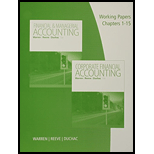
Income statement with variances:
The financial statement which reports revenues and expenses from business operations and the result of those operations as net income or net loss for a particular time period is referred to as income statement. In the income statement with variances, the balance of each variances account indicates the favorable and unfavorable variance at the end of the period.
Gross Profit:
Gross Profit is the difference between the net sales, and the cost of goods sold. Gross profit usually appears on the income statement of the company.
To prepare: An income statement through gross profit for the month ended March 31.
Explanation of Solution
The income statement through gross profit for the month ended March 31 for Company LB is as follows:
Company LB Income statement through gross profit For the month ended March 31,2016 |
|||
| Sales
|
$1,000,000 | ||
| Less: Cost of goods sold- at standards (1) | 675,200 | ||
| Gross- profit- at standards | $324,800 | ||
| Unfavorable $ (a) | Favorable $ (b) |
||
| Less: Variances adjustments to gross profit at standards | |||
| Direct materials price (5) | 2,050 | ||
| Direct materials quantity (6) | (4,000) | ||
| Direct labor rate (8) | (6,700) | ||
| Direct labor time (9) | (21,000) | ||
| Factory overhead controllable (11) | (3,240) | ||
| Factory overhead volume (12) | (480) | ||
| Net variances from |
(33,370) | ||
| Gross-profit | $291,430 | ||
Table (1)
Working notes:
To determine the cost of goods sold-at standards:
Determine the direct materials:
Determine the direct labor:
Determine the factory overheads:
The direct materials price variance is determined as follows:
The direct materials quantity variance is determined as follows:
The direct labor rate variance is determined as follows:
The direct labor time variance is determined as follows:
Determine the standard direct labor hours:
Determine the variable factory overhead controllable variance.
The fixed factory overhead volume variance is determined as follows:
Standard hours for actual units produced are determined as follows:
Therefore, the gross profit for Company LB is $291,430.
Want to see more full solutions like this?
Chapter 22 Solutions
Working Papers, Volume 1, Chapters 1-15 for Warren/Reeve/Duchac's Corporate Financial Accounting, 13th + Financial & Managerial Accounting, 13th
- The standard composition of workers and their wage rates for producing certain product during a given month are as follows:• 12 skilled workers @ OMR 8 per hour each• 8 semi-skilled workers @ OMR 6 per hour each• 10 unskilled workers @ OMR 4 per hour eachDuring the month, the actual composition of workers was:• 10 skilled workers @ OMR 9 per hour each• 6 semi-skilled workers @ OMR 5 per hour each• 8 unskilled workers @ OMR 3 per hour eachThe standard output of the group was expected to be 5 units per hour. However, the workers were unable to produce any output for 8 hours due to a power failure. The group of workers was engaged for 120 hours during the month, and 580 units of output were recorded calculate LCV, LRV, LEV, LIIV, LYV and LMVarrow_forwardAnswer? ? General Accountingarrow_forwardHelparrow_forward
 Managerial AccountingAccountingISBN:9781337912020Author:Carl Warren, Ph.d. Cma William B. TaylerPublisher:South-Western College Pub
Managerial AccountingAccountingISBN:9781337912020Author:Carl Warren, Ph.d. Cma William B. TaylerPublisher:South-Western College Pub Financial And Managerial AccountingAccountingISBN:9781337902663Author:WARREN, Carl S.Publisher:Cengage Learning,
Financial And Managerial AccountingAccountingISBN:9781337902663Author:WARREN, Carl S.Publisher:Cengage Learning, Cornerstones of Cost Management (Cornerstones Ser...AccountingISBN:9781305970663Author:Don R. Hansen, Maryanne M. MowenPublisher:Cengage Learning
Cornerstones of Cost Management (Cornerstones Ser...AccountingISBN:9781305970663Author:Don R. Hansen, Maryanne M. MowenPublisher:Cengage Learning- Principles of Accounting Volume 2AccountingISBN:9781947172609Author:OpenStaxPublisher:OpenStax College



